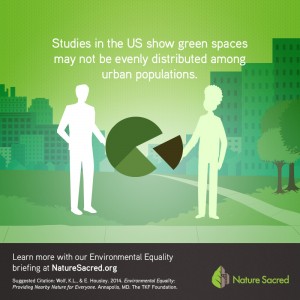In our Open Voices blog we share insight from leaders in our communities who are advancing what it means to have sacred, open green spaces in our cities. This month we examine the need for equal access to healthy urban spaces.

Every person, regardless of race, ethnicity, income, or age, is entitled to live in a home, neighborhood, and city that supports wellness and good health. Public discussions about environment and health have changed over time. Early scientific studies about health risks in communities focused on the presence of toxins or reduced environmental quality (of air or water, for example). There are notorious incidents (such as the chemical waste dumping at Love Canal) that raised public awareness about the effects of harmful substances. Many organizations and agencies are now committed to environmental justice, that is, to avoid or correct the unequal distribution of facilities or conditions that may endanger human health.
More recently, aligning with the growing evidence about the benefits of having access to nearby nature, there is commitment to equal access to the environments that promote health, wellness, and well-being. More recent public health studies note the absence or inadequate presence of trees, parks and open spaces in underserved neighborhoods. Even the smallest bits of nature in the city can make a positive difference in every person’s daily life. Several terms – environmental equity, environmental equality, environmental justice, and distributive justice – are used by agencies and organizations to also describe their commitment to providing parks, gardens, and open spaces to all city residents. The Nature Sacred program offers a collection of research discoveries, using the term environmental equality, to examine the issues and benefits that are important to consider in community planning for green space.
There are many factors that contribute to the challenged conditions of some urban communities. Having parks, gardens, and open spaces will not fully compensate for the social disservices of some places. Nonetheless, the experience of nature is now recognized as a major contributor to individual and community wellness. Research suggests that the positive effects of exposure to urban green spaces may be amplified in lower-income, urban communities:
- Experimental research concludes that poverty directly impedes cognitive function and that chronic poverty-related conditions can mentally exhaust individuals.1 Multiple studies have found that even brief experiences of nearby nature can enhance cognitive abilities.2 Urban forests and parks help to filter air pollution and reduce energy costs leading to significant economic value and health benefits to neighborhoods.3
- Crowding, noise pollution and the increased threat of crime in lower socio-economic, urban neighborhoods contributes to chronic mental and physical fatigue of residents.4, 5 Nature’s restorative effects help people cope with stressful situations, with possible effects on behavior.6
- In studies within public housing settings, there were fewer reports of personal and property crimes for buildings having greener surroundings.7
- Recent studies in several regions of the U.S. show green spaces may not be evenly distributed among urban populations. In addition to physical environment benefits, resident participation in urban greening programs is associated with community empowerment and social cohesion.8, 9, 10, 11
- In addition to physical environment benefits, resident participation in urban greening programs is associated with community empowerment and social cohesion.12
For an up-to-date review of health outcomes across the lifespan and how outcomes can play out in economic terms, we are pleased to share a recent paper from Nature Sacred’s research advisor, Kathleen Wolf:
“In this article, using a life course approach, we estimate the potential annual value of six metro nature benefits, and cautiously extrapolate to a national scale, based on best available data and research. This is done by applying established economic values associated with epidemiology and public health to metro nature benefits estimates reported in prior peer-reviewed literature. The six situations of benefits valuation potential focused on: birth weight, attention deficit hyperactivity disorder (ADHD), school performance, crime, cardiovascular disease, and Alzheimer’s disease. This benefits set demonstrates the importance of nature contact in urban areas over the course of the human lifespan. We estimate that the potential cost savings, avoided costs, and increased income range between $2.7 and $6.8 billion annually (2012 USD). Yet these values represent only a subset of benefits described in the current literature concerning urban nature experiences and health and well-being outcomes, pointing to the need for increased research concerning further valuations. We also point out challenges encountered in developing these estimates and limitations of their use. There is an urgent need to improve, expand, and integrate research methods and valuation strategies that link urban natural resources, public health, and economics. The resulting contributions to policy and programs can greatly improve urban quality of life.” Article Link
